Урок з англійської мови у 10 класі на тему "Energy saving"
Topic : Energy saving
Form : 10
Objectives:
- Students will be able to list resources of energy and classify each as renewable or nonrenewable.
- Students will be able to explain the importance of reducing fossil fuels consumption.
- Students will be able to practice key vocabulary on the topic.
Materials : the Internet, a laptop, a projector, mobile phones, video materials, worksheets.
Lead in.
![]()
![]() Students divide into several groups or pairs. Each group gets a set of words and orders them to make an energy saving slogan and sticks it to the board.
Students divide into several groups or pairs. Each group gets a set of words and orders them to make an energy saving slogan and sticks it to the board.
![]()
![]()
![]()
![]()
There is no excuse for energy misuse.
Do the Earth a favor. Be a power saver.
Do what’s right. Turn off the light.
The less you burn, the more you earn
Wasting of power is an invitation to future darkness.
Light up your life, and your savings too.
Save today enjoy tomorrow; waste today cry tomorrow.
After finishing the task and checking the word order offer your students to guess what the topic of the lesson is.
ENERGY SAVING
II. Short discussion
Ask your students next questions:
- Is energy saving an essential problem nowadays?
- Are you conscious that increasing consumption of energy threatens your future?
- Do you think it is not so serious and saving energy at home won’t change much for the world?
- Are here any people that have never thought about this problem and paid no attention to it?
Each student chooses his or her variant and takes a card
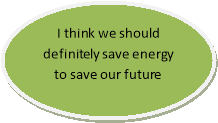

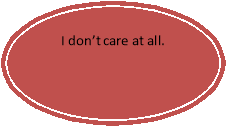
III. Vocabulary practice.
To understand the problem students should know where people get energy for their everyday needs.
Print names of energy resources each on a separate card. Ask students what energy resources they know. When someone names a resource give him or her a card with the name of the resource and ask to find the definition to the word. (the definitions
should be printed beforehand and laid on the table).
|
Oil /Petroleum |
||
|
Wind |
||
|
Biomass |
||
|
Nuclear |
||
|
Solar |
||
|
Geothermal |
||
|
Hydropower |
||
|
Coal |
||
|
Natural Gas |
||
|
Black rock burned to make electricity. |
||
|
Energy from heat inside the Earth. |
||
|
Energy from flowing water. |
||
|
Energy from wood, waste, and garbage. |
||
|
Energy from moving air. |
||
|
Energy from splitting atoms. |
||
|
Fossil fuel used mainly for the production of transportation fuels for cars, trucks, and jets. |
||
|
A mixture of gases which are rich in hydrocarbons. Fossil fuel gas moved by pipeline. |
||
|
Energy in waves from the sun. |
||
If students find it difficult to list all the resources help them showing the rest of the variants.
After that write on the board:
ENERGY
RENEWABLE NON-RENEWABLE
Make sure students understand the words and can explain their meaning
Renewable energy is energy capable of being renewed, not depleted when used.
Non-renewable energy is energy not able to be renewed, once consumed, cannot be replaced.
Ask students to stick the cards with the names of energy resources and their definitions to the right category.
IV. Watching a video
When they finish discuss what kind of energy consumption is better for the environment.
To confirm or refute their ideas watch a video “Formation of Fossil Fuels”. Students find out how fossils fuels are formed and why they are unsustainable.
https://www.youtube.com/watch?v=_8VqWKZIPrM
To check understanding do some post-watching activities.
Choose the right variant:
-
Fossil fuels are …
- unsustainable
- fragile
- cheap
-
Oil, coal and natural gas are made from ….
- metal and plastic
- rocks and sand
- plants and animals
-
To form fossil fuels the nature needs…
- thousands of years
- hundreds of millions of years
- several decades
-
….. turn buried plants and animals into fossil fuels
- the Earth’s heat and pressure
- wind and heat
- oxygen and sunlight
-
Woody plants form …
- oil
- coal
- marble
Ask your students whether they understand the reason to reduce fossil fuels consumption and why wasting them is threatening our future.
V. Presentation of the world consumption of energy resources.
After the short discussion offer your students to guess what the percentage of the world consumption of different energy resources (fossil fuels, nuclear, renewable) is. They get an upside down diagram with percentage on the one side and kinds of energy resources on the other. They pick up a share and name a resource, then turn the share to the other side and check their answers.
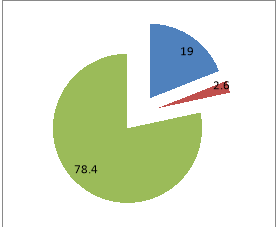
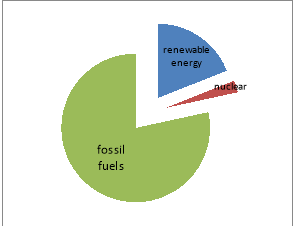
Show your students more detailed diagram and ask what should be changed to avoid problems in the future.
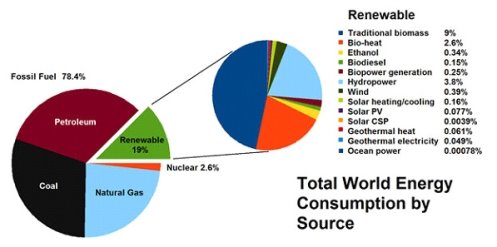
VI. On-line quiz
Tell your students that changes start with us. We cannot change energy policy in the world but we can save energy in our everyday life. Using electricity wisely is everyone's responsibility. To get the lowdown on their “electric personalities”, offer your children to take the quiz. It’s better to inform them in advance to have their gadgets at the lesson.
http://kids.saveonenergy.ca/en/whats-my-electric-personality/personality_quiz.aspx
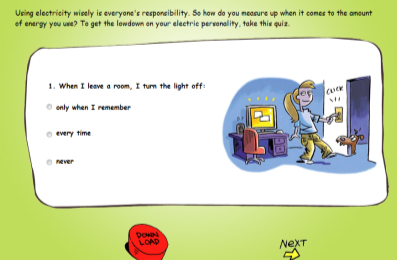
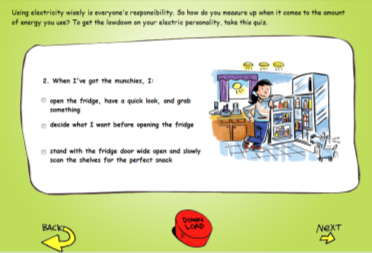
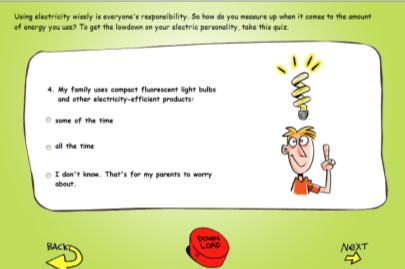
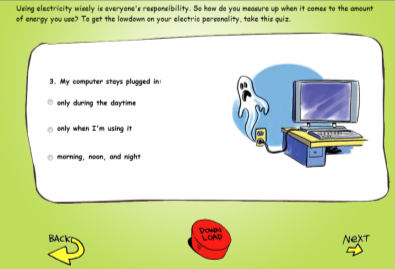
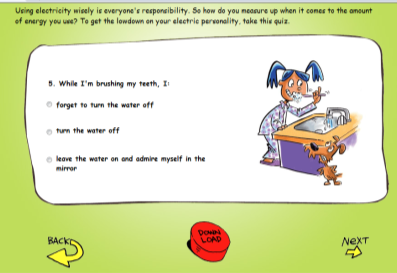
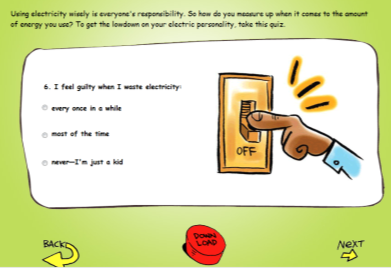
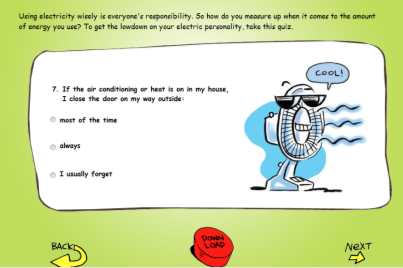
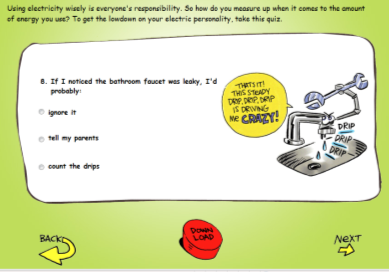
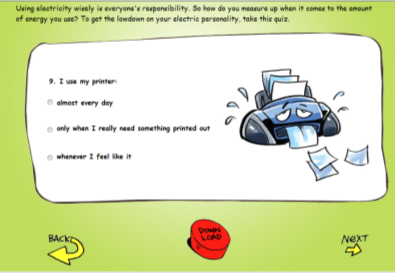
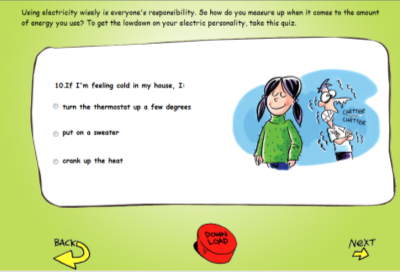
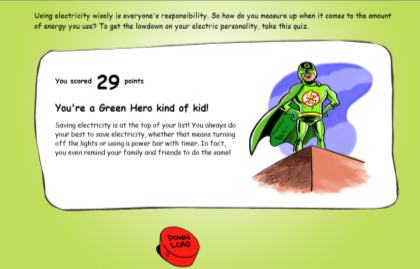
After they finish discuss briefly their results.
VII. Making “an electricity route”
Ask them whether they notice how much we depend on electricity and offer to make their “electricity route” from the moment they wake up till the bedtime. Instruct them to make notes.
Possible variants
Waking Up
Alarm Clock or Radio
Breakfast
Lights
Microwave
Toaster Oven/Toaster
Radio/CD Player/MP3 Player/iPod
TV/DVD Player
Gaming System
Shower/Bath
Hair Dryer
Curling Iron/Curlers/Flat Iron
Cell Phone
Computer
iPad/Tablet
After School
Air Conditioning/Heating
Lights
Computer /iPad/Tablet
Gaming System
Radio/CD Player/MP3 Player/iPod
TV
Cell Phone
Last Night
Air Conditioning/Heating
Microwave
Refrigerator
Lights
TV
Shower/Bath
Hair Dryer
Cell Phone
Computer/iPad/Tablet
Give students several minutes to share the information with each other and compare their routes.
VIII. Hometask
Ask your students to use their notes to make “saving routes”. They should think about all possible ways to save energy following their everyday routine and try them practically.
Instruct students to make energy saving tips for the next lesson.
IX. Assessment
References
- DUCKSTERS www.ducksters.com
- EIA ENERGY KIDS www.eia.gov/kids/energy.php?page=5
- ENERGY STAR® www.energystar.gov
- Energy Kid’s Page www.eia.gov/kids
- Energy-efficient house http://www.scootle.edu.au/ec/viewing/L895/L895/index.html#
- Energy Activities Green Education Foundation http://www.greeneducationfoundation.org
- EVERYKILOWATTCOUNTS www.everykilowattcounts.com/kids
- KIDS’ CORNER http://kids.saveonenergy.ca


про публікацію авторської розробки
Додати розробку
